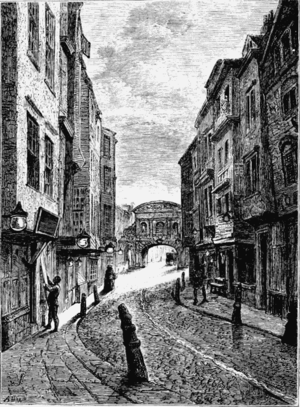Annotation:Butcher Row: Difference between revisions
Created page with "=='''Back to [[{{BASEPAGENAME}}]]'''== ---- <p><font face="garamond, serif" size="4"> '''BUTCHER ROW'''. English, Jig. G Major. Standard tuning (fiddle). AABBCCDDetc. The melo..." |
No edit summary |
||
| (9 intermediate revisions by 2 users not shown) | |||
| Line 1: | Line 1: | ||
---------- | |||
---- | {{TuneAnnotation | ||
|f_tune_annotation_title= https://tunearch.org/wiki/Annotation:Butcher_Row > | |||
'''BUTCHER ROW'''. English, Jig. | |f_annotation=[[File:Butcherrow.gif|thumb|A Victorian ear depiction of Butcher Row, with Temple Bar in the background]]<br>'''BUTCHER ROW'''. English, Jig (6/8 time). D Major. Standard tuning (fiddle). AABBCCDDetc. The melody appears in London publisher John Walsh's '''Third Collection''' (1730) of (as a period advertisement gives) "The Most Celebrated Jiggs, Lancashire Hornpipes, Scotch and Highland Lilts, Northern Frisks, Morris's and Cheshire Rounds". Walsh was one of the leading music publishers of his era, although whether he took any active role in the selection of the music contained is unknown. He issued two earlier volumes of his series of "Jiggs", although neither seem to have survived. | ||
<br> | <br> | ||
<br> | <br> | ||
< | Walsh's curious two-bar parts in "Butcher's Row" are not full parts; only the first two measures are given for each part, and it is assumed that the player who reads them will fill in the remainder, using the first two measures as a guide. Thus there are prompts for twenty-nine variation sets. The tonality also shifts from No. 5 onwards, with the keynote going from 'D' to 'A' with a flattened seventh (effectively from the key of 'D' to the key of A Mixolydian)<ref>R.D. Cannon, "English Bagpipe Music", '''Folk Music Journal''', vol. 2, No. 3, 1972, p. 206. </ref>. | ||
'' | |||
<br> | <br> | ||
<br> | <br> | ||
Butcher Row is a location in London near the Temple Bar, the site of a meat market. Mr. John Timbs described the houses in Butcher's Row as having been mostly built in Queen Elizabeth's time, and constructed of wood and plaster, with overhanging eaves. "They were," he writes, "wretched fabrics, the receptacles of filth in every corner, the bane of old London, and a sort of nestling-place for the plague and fevers. The ceilings were low, with large unwrought beams, and lighted by small casement windows. The cant name for the place among coachmen in the days of the Spectator was the 'Pass,' or the 'Straits of St. Clement's.'"<ref>Quoted in British History Online [https://www.british-history.ac.uk/old-new-london/vol3/pp10-15]</ref> | |||
|f_source_for_notated_version= | |||
'' | |f_printed_sources= | ||
< | |f_recorded_sources= | ||
|f_see_also_listing= | |||
}} | |||
------------- | |||
---- | |||
Latest revision as of 20:32, 9 June 2023
X:54 T:Butcher Row A:England;London M:6/8 L:1/8 Q:3/8=100 S:J.Walsh,Third Book of the most celebrated jiggs,etc 1731 N:aka 'Pibroch'(D.Johnson)[RC}; extra pick-up notes as printed; strain 10 N:has leading note in same bar; Z:Pete Stewart, 2004 <www.hornpipemusic.co.uk> with vmp revisions K:D g|f>ga a2g|f>ga gdB||\ g| f>ga e>fg|f>ga gdB|| g|f2e f/e/f/g/a|gec fdB||\ e>fe cAd|cdc fdB|| ABA cAd|cec fdB||\ cAd cAd cac BdB|| a2e f/e/f/g/a|g/f/e/d/c f/e/d/c/B||\ e>fe f/e/f/g/a|g/f/e/d/c f/e/d/c/B|| aec aec|aec BGB||\ B |c>Bc c>Bc|c>Bc BGB|| ceA dfA|ceA fdB||\ cac dbd|cac BGB|| A>BA cAd|cec fdB||\ e3g3|aec fdB|| e>fe f>ga|gec fdB||\ e3c3|cec fdB|| A3c3|c3 BGB||\ cAd cAd|cec fdB|| e3g3|a2cB2g||\ a2c a2c|a2cB2g|| a3e3|cec fdB||\ A/A/A/A/e A/A/A/A/e|A/A/A/A/e BGB|| A/A/A/A/e A/A/A/A/g|A/A/A/A/e BGB||\ A/A/A/A/A cAc|A/A/A/A/A BGB|| e/e/e/e/e cAc|e/e/e/e/e BGB||\ a/a/a/a/a cAc|a/a/a/a/a BGB|| A/A/A/A/A A/A/A/A/A|A/A/A/A/A BGB||\ A3d3|c2BGB|| cAd cAd|cAd BGB||\ aec aec|aec fdB|]

BUTCHER ROW. English, Jig (6/8 time). D Major. Standard tuning (fiddle). AABBCCDDetc. The melody appears in London publisher John Walsh's Third Collection (1730) of (as a period advertisement gives) "The Most Celebrated Jiggs, Lancashire Hornpipes, Scotch and Highland Lilts, Northern Frisks, Morris's and Cheshire Rounds". Walsh was one of the leading music publishers of his era, although whether he took any active role in the selection of the music contained is unknown. He issued two earlier volumes of his series of "Jiggs", although neither seem to have survived.
Walsh's curious two-bar parts in "Butcher's Row" are not full parts; only the first two measures are given for each part, and it is assumed that the player who reads them will fill in the remainder, using the first two measures as a guide. Thus there are prompts for twenty-nine variation sets. The tonality also shifts from No. 5 onwards, with the keynote going from 'D' to 'A' with a flattened seventh (effectively from the key of 'D' to the key of A Mixolydian)[1].
Butcher Row is a location in London near the Temple Bar, the site of a meat market. Mr. John Timbs described the houses in Butcher's Row as having been mostly built in Queen Elizabeth's time, and constructed of wood and plaster, with overhanging eaves. "They were," he writes, "wretched fabrics, the receptacles of filth in every corner, the bane of old London, and a sort of nestling-place for the plague and fevers. The ceilings were low, with large unwrought beams, and lighted by small casement windows. The cant name for the place among coachmen in the days of the Spectator was the 'Pass,' or the 'Straits of St. Clement's.'"[2]

